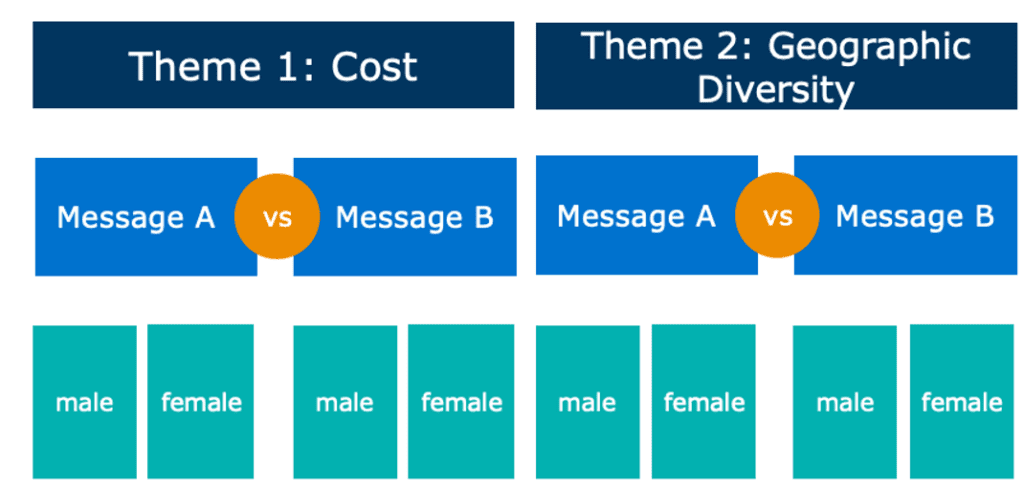Stealth shoppers are everywhere. Here’s how to reach them.
The concept of “stealth shoppers,” or students that are unknown to your institution until they actually submit an application, is not a new one. But that doesn’t mean graduate and adult-serving program enrollment marketers have figured out how to pin them down. Not only are they challenging to identify—they’re also exceptionally busy. No adult student’s journey is the same as any other, because they are all balancing so many other priorities, like childcare or a full-time job. To reach these fast-moving students wherever they are in their student journey, it’s important to prioritize building a marketing strategy that stretches across multiple platforms.
Here are four strategies you can implement to reach and engage stealth shoppers using multichannel marketing.
1. Retarget with first-party cookies to engage students on your site and others.
In the quest to engage stealth shoppers, the first step has to be de-stealthing them. Retargeting has long been an effective tactic to do this. Historically, it’s been done using third-party cookies, which have the capacity to follow your users across multiple websites and serve them ads to get them back to your site. But recent concerns about online privacy have complicated the use of third-party cookies. Over the past few years, web browsers have taken steps to limit the use and impact of third-party cookies, which affects the efficacy of retargeting. Luckily, you’re probably already using another tool that can still help you retarget amid these changes: first-party cookies.
Most sites already use first-party cookies, since they are important for the functionality of things like site analytics and embedded forms. Here’s how they work: When someone visits your .edu site, a first-party cookie is placed on their browser. This cookie tracks their behavior on your site, such as pages viewed, time spent on each page, and programs they showed an interest in. You can then use this data to not only personalize your users’ experience on your site, but also to retarget them from other sites. Use your first-party cookie data to create audience segments based on groups of students you’d like to engage, like students who click on a specific program page or use your tuition calculator. Even though first-party cookies don’t have cross-site tracking capabilities, your ad platform (Google Ads, Facebook Ads, etc.) does. Once a user is placed in a segment, if the ad platform recognizes the student on another website, it can serve them segment-relevant ads that encourage them to take action: revisit your .edu site, complete a lead generation form, or whatever you choose.
This process does require extra work from your institution’s marketing team, so it isn’t as easy as third-party cookie retargeting. But as fears about consumer privacy continue to ramp up, it’s important to know that you can still engage stealth students after they leave your site, while still maintaining user privacy.
Do you know how best to engage stealth shoppers?
 2. Create digital advertisements that cut through market noise.
2. Create digital advertisements that cut through market noise.
Digital ads are a great way to catch the attention of students across channels, but increased competition among graduate and adult programs make this more complicated. From 2005 to 2021, the number of graduate programs in the US increased by nearly 70%, crowding the market and making it more difficult for you to stand out among the many ads students see every day.
To ensure your ads will resonate with your target audience, test your digital ad messaging. We recommend first conducting research to find out the top challenges, preferences, and pain points of your applicants, current students, and alumni. Analyze your results and determine a list of themes that represent topics that would best resonate with your audience. For instance, maybe your students are most concerned about finding a flexible online program, time to program completion, or postgraduate career outcomes. Pick three or four themes from your full list that you want to A/B test in the market, then craft messages based on each theme, with variations in ad imagery to test alongside each message. Here’s a diagram of the approach we used in some of our digital ad testing, showing two of many possible themes:

In this example, we are testing each message with an image of a man vs. an image of a woman, but the variations are endless: you could test different colors, showing images of families vs. individual people, or people vs. views of your campus. This approach allows you to convey your message while also homing in on the highest-converting creative combinations.
Keep in mind that the work doesn’t stop after your creative is live! In today’s highly competitive environment, marketers need to be constantly testing and innovating. That can help you ensure your ads don’t become stale and overlooked.
Learn strategies to help you create high-quality creative that cuts through the noise
3. Optimize your content marketing, then integrate it into your platforms.
Now that you know what topics resonate most with your target audience, it’s important to ensure your website appears in page results when students search for those topics. Use your research to inform your web content, especially your social proof. Reach out to your alumni to find out if they have success stories that would assuage the concerns of stealth students. By understanding what prospective students are most worried about—whether it’s balancing work and studies, achieving career advancement, or managing the financial investment—you can tailor your social proof content to address these specific issues. This approach not only makes your content more effective but also builds a strong emotional connection with your audience by directly addressing their aspirations and challenges.
Learn more about best practices to boost organic lead generation strategy
Once you’ve developed digital content that’s optimized to speak to your audience, it’s important that they see it on multiple channels. Consider featuring the content on your .edu site and social media. Incorporating this content into your multichannel strategy also allows you to nurture leads over time. By consistently producing relevant information that speaks to students’ specific concerns and interests, you build trust and keep your institution top of mind as they progress through their research. Integrating this optimized content into your multichannel approach not only increases its visibility but also strengthens its impact, helping you to effectively engage and convert stealth shoppers.
4. Incorporate high-volume sources that maintain lead quality
While it’s important to use the above strategies to attract and engage stealth shoppers, it can still be a challenge to fill your classes without knowing who is interested in your programs. My last tip is to make sure that you’re also balancing these tactics with lead generation sources that provide a high volume of leads to help fill the gap. Appily Advance is a great example. Not only can Appily generate a large pool of leads for you to nurture, it also delivers curated lists of leads to partners, so you know you’re receiving both quantity and quality.
Appily Advance
Appily Advance connects institutions with high-intent leads. With 15+ years of experience supporting undergraduate enrollment, Appily (formerly Cappex) now serves graduate & adult-serving programs, too. Visit eab.com/appily-advance to learn more.
In the constantly changing landscape of higher ed, the challenge of reaching stealth shoppers remains significant. By implementing these multichannel strategies, you’ll be better equipped to engage this challenging audience, meeting them where they are and guiding them towards your programs.

More Blogs

4 questions domestic students will ask before applying to your graduate program

When Grad PLUS disappears: What 8,000+ grad students said about paying for school

 2. Create digital advertisements that cut through market noise.
2. Create digital advertisements that cut through market noise.